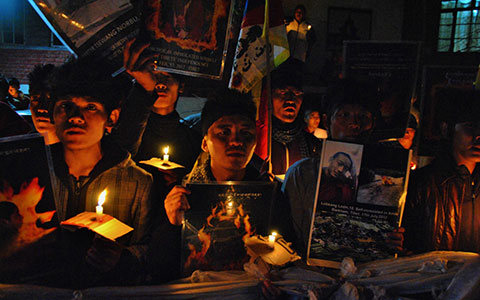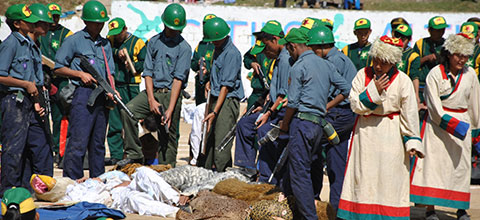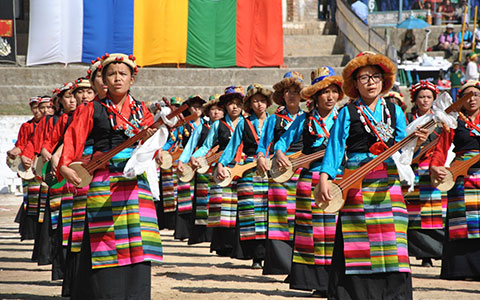Tibetan self-immolations on the rise as China's assimilation policy backfires spectacularly
by - 14th August 2013

China has used both carrot and stick to dissuade Tibetans from burning themselves in protest at its rule, and yet at least 120 Tibetans have self-immolated, and the tally is rising by the month.
Last week, a Tibetan man set himself ablaze at a Buddhist monument in Kathmandu, the third such incident in Nepal, where the government is cracking down on the 2,000 Tibetan refugees under pressure from neighbouring China.
Most Tibetan self-immolations have followed a pattern. A young monk or nun typically drinks kerosene and pours it all over the body before lighting a match. Once in flames, she or he runs into the street, calling for the return of the Tibetan spiritual leader, the Dalai Lama, from exile, and the restoration of freedom in Tibet.
The first Tibetan to self-immolate in recent years was a 20-year-old monk, named Tapey, from Kirti Monastery in Sichuan Province’s Ngaba area. He burned himself on 27 February 2009, apparently to protest the cancellation of a ceremony to commemorate ten Tibetans who were killed during the 2008 protests before the Beijing Olympics.
Police shot Tapey soon after he set himself alight, and took him away.
His whereabouts remain unknown until today, Tenzin Lekshay, Media Coordinator at the Bureau of His Holiness the Dalai Lama in New Delhi told Lapido.
No other monk followed suit for two years until 21-year-old monk, Phuntsok, also from Kirti Monastery, self-immolated on March 16, 2011. His self-immolation came five days after the Dalai Lama announced his intention to retire as political head of the exiled Tibetan movement.
“While His Holiness believed devolution of his political powers was needed for the sustenance of the Tibetan struggle, the announcement led to a sense of insecurity among the Tibetans,” Lekshay said.
Phuntsok’s death was followed by a hunger strike by school students in the area.
Chinese authorities responded with a major crackdown on Kirti Monastery. Security was intensified in Ngaba area, a ‘patriotic re-education campaign’ was launched at the monastery, several monks and local residents were arrested, security personnel raided the monastery, and two local residents were killed in subsequent protests.
Phuntsok’s self-immolation set off not just extreme repression by Beijing, but also triggered a domino effect among the Buddhist clergy.
Amid the clampdown on monks and nuns, another self-immolation was reported on 15 August 2011. One month later, on 26 September, yet another monk self-immolated. Since then, the number has been rising month by month.
Almost all self-immolators have been young. They were born after the Chinese occupation of Tibet and have never met the Dalai Lama, who fled after a failed 1959 uprising.
However, Beijing has accused the Dalai Lama of inciting the self-immolations, ignoring flaws in its own policy on Tibet.

Self-immolations are damaging China’s international reputation, at a time when its global business is expanding together with its superpower aspirations. Even domestically, Tibetan protests are an impediment to China’s emphasis on social harmony within its territories.
China’s desperate response to self-immolations has been characterised by material coercion and allurement.
Their use of the stick in Tibetan areas has been marked by a heavy military presence, arbitrary arrests, custodial torture, killings, total control over monasteries, communication blackouts and restrictions on public gatherings.
Beijing’s carrot to Tibet includes investment of billions of dollars to build infrastructure in Tibetan areas including roads and airports, the offer of tax breaks, establishment of factories, promotion of tourism and revival of traditional handicrafts, among other measures.
However, alongside these development measures, Beijing is also overseeing a great influx of migrants into Tibetan areas. Critics say the benefits of development are mostly going to these migrants.
China has a strong military and economy, and clout at the United Nations and is slowly but steadily destroying the distinctive cultural landscape of Tibet with little or no accountability.
The Chinese government has censored the press and the Internet, and banned the entry of foreign journalists and human rights activists into troubled Tibetan areas, leaving no room for Tibetans to communicate with the outside world. Officials send Tibetans to jail for carrying a picture of the Dalai Lama.
In the last seven years, more than two million Tibetans have been forcibly relocated into resettlement enclaves or so-called New Socialist Villages, according to Human Rights Watch. The government has also announced reconstruction of Lhasa’s old town, where some of Tibetan Buddhism’s most sacred monuments exist.
China can also choke the cultural and religious expressions of the Tibetans, around which their unique identity was formed over the centuries.
However, Beijing has failed to crush the Tibetan spirit.

China’s Tibet policy can be seen as a redux of the Cultural Revolution, which sought to eliminate religion throughout the country by force in the 1960s and the 1970s.
Mao Zedong succeeded in abolishing all public religious expression, but failed to take religion out of citizens’ hearts. As a result, religion returned with even greater fervour. The growth of the Christian house church movement in China, for example, is like nowhere else in the world.
According to Li Fan, director of the Beijing-based think-tank World and China Institute, China’s house churches have become the most powerful non-governmental organization in the country, comprising nearly 1 million worship and meeting places and accounting for about 50 percent of China’s NGO population.
There are now an estimated 70 million to 80 million Christians in China according to conservative estimate. Non-government-approved house churches all over the country have 'tremendous comprehensive strength and rich experience in coping with suppression', and will not be ‘smothered’, according to one observer.
‘Liberalistic theories, Internet, and house churches are the strongest cornerstones for China’s future democracy and rule of law’, says Professor Li Fan, quoted in Chinese Law and Religion Monitor in 2009 (p. 10).
China has no reason to believe that the Tibetans will one day adopt a fluid identity and a materialist outlook – a prerequisite for Tibet’s assimilation into the state-promoted Chinese culture.
Self-immolation is the strongest possible refusal of subjugation. Even hard-core communist psychologists cannot deny the fact that no other group of people in the world has made this statement as passionately as the Tibetans.
- Log in to post comments
